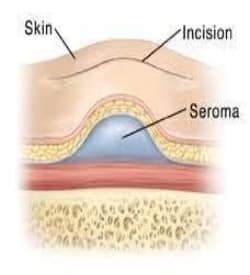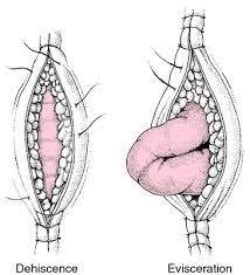Prevention and Treatment of Seromas and Dehisced Surgical Wounds
What is a seroma?
A seroma is a localized accumulation of serous fluid in a part of the body, occurring most commonly as a complication of a surgical procedure.
What is the risk of an untreated seroma?
Small seromas often regress into the body on their own; those that remain can be aspirated using a needle and syringe. If a seroma persists, surgical removal may be considered. Large, untreated seromas pose an increased risk of infection, and they may develop a fibrous capsule, complicating drainage.
What does a seroma look like?
In many cases, a seroma will have the appearance of a swollen lump, like a large cyst. It may also be tender or sore when touched. A clear discharge from the surgical incision is common when a seroma is present. You may have an infection if the discharge becomes bloody, changes color, or develops an odor.

What kind of surgeries are more commonly associated with seroma formation?
Seromas can occur after several different types of surgeries, especially those that are extensive or involve significant tissue disruption. These include hernia repairs, significant plastic surgeries such as breast augmentation or reconstruction, abdominoplasties (tummy tucks), and surgeries performed for breast cancer. Seroma formation may be associated with an increased risk of infection and breakdown of the surgical site.
What can help reduce the risk of surgical seromas?
Surgical drain tubes with bulb suction devices are used after some surgeries to help reduce the risk of seroma formation. These allow for monitoring the volume of fluid leakage, and once drainage becomes minimal, the drains are removed. Seromas can form shortly after surgery if drains are not used, and they may also occur after removal of a drain.

What is a Dehiscence?
If an incision separates following surgery, the wound is considered “dehisced.” This means it has split along a natural line. The split can happen in just the skin layers, or the entire wound can open back up.
How is a seroma related to a dehiscence?
If a seroma forms after a surgical procedure, it will place mechanical stress on the incision. As the stress on the incision increases a dehiscence may occur. Prevention or early intervention of post-operative seromas can prevent a dehiscence from occurring. Interventions include drains or aspirations of the fluid. Prevention of seroma formation can be achieved by prevention of a dead space where a seroma can occur.
What can be done post-operatively to reduce the risk of seromas?
Prevention of these pockets (dead spaces) can be achieved by post-operative compression as well as the use available biologics. The biologics used should have the physical characteristics of barrier formation to reduce drainage of serous fluid into the post-operative dead space as well as a tackiness that will allow for prevention of a dead space by holding separated tissue planes together.
For more information about a product indicated for the management of surgical wounds, please visit https://sanaramedtech.com/surgical/celleraterx-surgical/




